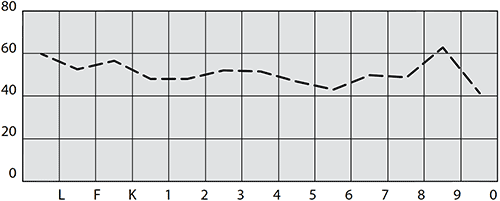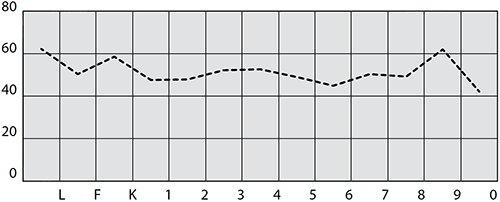Article
Belousova А.K., Evseeva O.E., Nikolaev A.Ur. (2018). Features of personal profile in MMPI males with experience of primary samples of psychoactive substances. National Psychological Journal, 11(2), 66–74
Abstract
Background. The increase in drug use in the population of Russia and representatives of the youth in particular is a vital issue that is controlled and monitored by the federal state. The rapid rise in drug use in young citizens requires a systematic analysis of the causes, study of criteria and assessment of predisposition for drug use, and also the development of programs to prevent drug addiction in adolescents.
Objective. Determination of the psychological predisposition of young men to psychoactive substances using the personality profile of the Multidisciplinary Method of Personality Inventory (MMPI).
Research Progress. The research was conducted between 2008 and 2010 on the basis of secondary comprehensive schools, cadet corps, secondary professional educational institutions and universities in Rostov-on-Don and the Rostov region, Russia. The sample included 338 males from 15-16 to 22-23 years old, whose average age is 17-18 years. The evaluation of information reported by applicants on the fact of presence / absence of psychoactive substance samples was made based on the results of the psychophysiological test using a polygraph.
Research Results. The results of the MMPI test were statistically analyzed according to the nonparametric Mann-Whitney test, and to a single-factor analysis of variance. The research results show that the scores of the F-scale in the MMPI profile of young males who used psychoactive substances reveal a statistically significant increase (p = 0.008), compared to those who did not use psychoactive substances. The single-factor analysis of the F- MMPI scale did not show a statistically significant difference (p = 0.128).
Conclusion. The paper proposes to consider an increase in the F-scale in the MMPI profile as an indicator of individual predisposition to use psychoactive substances, but not to consider an increase in its indices as a cause that affects primary psychoactive substances in adolescence. The results obtained can be used by practical and clinical psychologists when working with adolescents and youths.
Accepted: 12/10/2017
Pages: 66-74
DOI: 10.11621/npj.2018.0208
PDF: Download
Keywords: psychoactive substances; psychophysiological investigation using a polygraph; reliability scale (F); late adolescence; psychological predisposition; drug abuse; addiction;
Available Online 01.08.2018

Fig 1. The MMPI average profile of the experimental group Experimental group

Fig 2. The MMPI average profile of the control group Control group
Table 1. (p) value in the Mann Whitney test for the MMPI test
|
MMPI Scale |
L |
F |
К |
1 |
2 |
3 |
4 |
5 |
6 |
7 |
8 |
9 |
0 |
|
аэ |
59,9 |
52,6 |
56,8 |
48,3 |
48,3 |
52,1 |
51,7 |
46,9 |
43,3 |
50 |
49 |
62,9 |
41,5 |
|
ак |
62,2 |
50,3 |
58,5 |
47,6 |
47,8 |
52 |
52,6 |
48,8 |
44,8 |
50,3 |
49,1 |
61,9 |
42 |
|
Δ |
2,3 |
2,3 |
1,7 |
0.7 |
0,5 |
0,1 |
0,9 |
1,9 |
1,5 |
0,3 |
0,1 |
1,0 |
0,5 |
|
(р) |
0,23 |
0,008 |
0,06 |
0,66 |
0,27 |
0,35 |
0,96 |
0,3 |
0,47 |
0,58 |
0,94 |
0,53 |
0,41 |
Table 2. F-scale statistical analysis ('BioStat' 2009)
|
Sample 1 |
171 |
Sample 2 |
167 |
|
W1 Ranks Total (line 1) |
31358.5 |
W2 Ranks Total (line 2) |
25932.5 |
|
|
|
(р) value |
0.00821484 |
Table 3. Single-factor variance analysis of MMPI (F) value
|
|
SS |
Degrees of freedom |
MS |
F |
Value |
|
Between groups |
8,225 |
25 |
0,329 |
1,346 |
0,128 |
|
Within a group |
76,263 |
312 |
0,244 |
|
|
|
Total |
84,488 |
337 |
|
|
|
References:
Ability of minors and underage. – Retrieved form: http://prokuror-kaluga.ru/razyasnenie-2259.html (accessed: 10.10.2017)
Analyst Soft Inc., BioStat. 2009 version. Retrieved from: www.analystsoft.com/ru/ (accessed: 10.10.2017).
Annual reports on the drug situation in the Rostov region and on the work of the antinarcotics commission of the Rostov region in 2016. Retrieved form: http://www.donland.ru/Default.aspx?pageid=129434#p1 (accessed: 10.10.2017)
Bayanova L.F., Chulyukin K.S. (2018). The impact of cultural congruence on the creative thinking of primary school children. Psychology in Russia: State of the Art, 11 (1), 61–70. doi: 10.11621/pir.2018.0105
Budyakova T. P. (2017). Psychological and legal aspects of the offensiveness of male and female cartoons and collages. Psychology in Russia: State of the Art, 10(2), 149–164. doi: 10.11621/pir.2017.0210
Belousova, A. (2010) Initiation of Collaborative Thinking Activity Self-Organization / A. Belousova / Saarbrucken, Germany, LAMBERT Academic Publishing, 182.
Belousova, A.K. (2002) Self-organization of joint intellectual activity. Rostov-on-Don, Izdatel’stvo RGPU, 360.
Belogurov, S.B. (2000) In layman’s terms about drugs and drug addiction. St. Petersburg, Nevskiy dialekt, 240.
Belousova, A.K., & Evseeva, O.E. (2014) Identification of the experience of the first drug test in university applicants of law enforcement agencies of Russia. [Nauchnyy portal MVD Rossii]. Moscow, FKGU «EPC MVD Possii», 113–119.
Belousova, A.K., Evseeva, O.E., & Nikolaev, A.Yu. (2013) Intellectual features of young men with experience of using psychoactive substances. [Zhurnal Yuridicheskoy Psikhologii], 4, 25–28.
Belousova, A.K., Evseyeva, O.E., & Nikolaev, A.Yu. (2014) Cognitive sphere of the adolescent drug addict. [Zhurnal Prikladnaya Yuridicheskaya Psikhologiya], 2, 37–46.
Berezin, S.V., Lisetskiy, K.S., & Motynga, I.A. (1997) Psychology of early addiction. Samara.
Berezin, S.V., Lisetskiy, K.S., & Nazarov, E.A. (2001) Psychology of drug addiction and codependence: monograph. Moscow, MPA.
Berezin, F.B., Miroshnikov, M.P., & Sokolova, E.D. (2011) Method of multilateral personality inventory. Structure, interpretation criteria, areas of application. Moscow, 320.
Caputo, R. (1993) Volatile substance misuse in children and youth: A consideration of theories. Int. J. Addict, 23(1)0,1015–1032. doi:10.3109/10826089309062180
Cattell, R.B., Eber, H.W., & Tatsuoka, M.M. (1970) Handbook of the sixteen personality factor questionnaire (16 PF) / R.B. Cattell, H.W. Eber, M.M. Tatsuoka. Compaign Illinois, 388.
Cohen, S. (1995) Overdiagnosis of shizophrenia: Role of alcohol and drug misuse. Lanchet, 8989, 1541–1542. doi:10.1016/S0140-6736(95)92058-7
(1995) Complex methodology of special psychophysiological test using polygraph / NII-2 of the FSUE of the FSB of Russia. Moscow, 66.
Dahlstrom, W. G., & Welsh, G. S. (1960) An MMPI handbook. Minneapolis.
Donald, J. Krapohl, & Pamela, Shaw (2015) Fundamentals of Polygraph Practice 1st Edition. Academic Press, 364
Donald, J. Krapohl. (2016) Paradigm Shift: Searching for Trace Evidence in Human Memory. Journal of Тhe Рolice Сhief, 52–55
Drogen: Soziale und gesundheitliche Folgen Retrieved form: http://jugendinfo.be/leben/drogen_folgen.php (accessed: 25.10.2017)
Farwell, L. A. & Smith, S. S. (2001) Using Brain MERMER Testing to Detect Concealed Knowledge Despite Efforts to Conceal. Journal of Forensic Sciences, 46(1), 1–9. doi:10.1520/JFS14925J
Gannushkin, P.B. (2007) Clin1956) Basic readings on MMPI in psychology and medicine. Minneapolis.
Jonson, B. (1993) A developmental model of addictions and it’s relationships to the twelve step program of alcoholics anonymous. J. Subst, 10(1), 23–24.
Kholodnyy, Yu.I. (2008) Polygraph ezamination and its natural science basis. [Poligraf v Rossii 1993-2008]. Moscow: MGTU im. Baumana, Moscow, 60–86.
Klochko, V.E., & Galazhinsky, E.V. (2000) Personality aelf-actualization: a systemic view. Tomsk, Izdatel’stvo «TGU», 154.
Koch, J.V., & Grupp, S.E. (1971) The economics of drug control policies. International Journal of the Addictions, 6(4), 571–584. doi:10.3109/10826087109058954
Lesswing, N., & Dougherty, R. (1993) Psychopathology in alcohol and cocaine – dependent patients: a comparison jf findings from psychological testing. J. Subst. Abuse Treat, 10(1), 53–57. doi:10.1016/0740-5472(93)90098-M
Lisetsky, K.S. (2006) Primary prevention of drug addiction. Samara, Univers-grupp.
Lisetsky K.S. (2008) Psychological bases of drug addiction prevention: Ph.D. in Psychology, Thesis. Moscow, 467.
Mann, H.B., & Whitney, D.R. (1947) On a test of whether one of two random variables is stochastically larger than the other. Annals of Mathematical Statistics, 18, 50–60. doi:10.1214/aoms/1177730491
Nasledov, A.D. (2008) Mathematical methods of psychological research. Analysis and interpretation of data: tutorial. St. Petersburg, Rech’. 392.
Neiss, R. (1993) The role of psychobiologcal states is chemical dependency: Who becomes addicted. Addiction, 88(6), 745–756. doi:10.1111/j.1360-0443.1993.tb02089.x
Nikolaev, A. Yu. (2011) Psychophysiological study of memory as a method of forensic diagnostics. [Yuridicheskaya Psikhologiya], 4, 14–18.
Nurco, D., & Batter, M. (1994) Vulnerability to narcotic addiction: findings. J. Drug, 24(1–2), 293–314. doi:10.1177/002204269402400206
Oaklander, Violet (1989) Windows to Our Children. Gestalt Journal Press, 335.
Ogloblin, S.I., & Molchanov, A.Yu. (2004) Tooling of «lie detection»: academic course. Yaroslavl’, Nyuans, 464.
Petrovsky, A.V. (1998) Category of personality/ Fundamentals of theoretical psychology. Moscow, INFRA-M, 223–270.
Puchkova E.B., Sukhovershina Yu.V., Temnova L.V. (2017). A study of Generation Z’s involvement in virtual reality. Psychology in Russia: State of the Art, 10(4), 134–143. doi: 10.11621/pir.2017.0412
Rerke, V. I. (2008) Psychological and pedagogical conditions for the prevention of adolescent drug addiction: theory and practice. Irkutsk, Izdatel’stvo GOU VPO «IGPU», 318.
Sobchik, L.N. (2007) MMPI. Standardized multifactor method of personality inventory. St. Petersburg, Rech, 224.
(2017) Socially significant diseases of the Russia’s population in 2016. (statistical materials). Federal State Institution «Central Research Institute of Healthcare Organization and Informatization». Moscow. Retrieved from: https://www.rosminzdrav.ru/ministry/61/22/stranitsa-979/statisticheskaya-informatsiya-minzdrava-rossii - (accessed: 10.10.2017)
SPSS Inc. SPSS 2101. 2012 version. Retrieved from: http://www-01.ibm.com/software/analytics/spss/ (accessed: 10.10.2017)
Stevens, M.C., Kaplan, R.F., & Bauer, L.O. (2001) Relationship of cognitive ability to the developmental course of antisocial behavior in substance dependent patients. Prog. Neuro-Psychopharmacol. Biol. Psychiatry, 25, 1523–1536. doi:10.1016/S0278-5846(01)00210-X
Stevens, M.C., Kaplan, R.F., & Hesselbrock, V.M. (2003) Executive-cognitive functioning in the development of antisocial personality disorder. Addict. Behav, 28(2), 285–300. doi:10.1016/S0306-4603(01)00232-5
Tsvetkova, L.A., Gurvich, I.N., Shaboltas, A.V. et al. (2006) Theoretical models of development, control and correction of drug use. St. Petersburg, Izdatel’stvo Sankt-Peterburgskogo universiteta, 2458, [1].
Velichkovsky B.M. (2017). Cognitive science: The art and its implications. Psychology in Russia: State of the Art, 10 (3), 2–7. doi: 10.11621/pir.2017.0300
Zmanovskaya, E.V. (2008) Psychology of deviant behaviour. Moscow, Akademiya, 288For citing this article:
Belousova А.K., Evseeva O.E., Nikolaev A.Ur. (2018). Features of personal profile in MMPI males with experience of primary samples of psychoactive substances. National Psychological Journal, 11(2), 66–74


